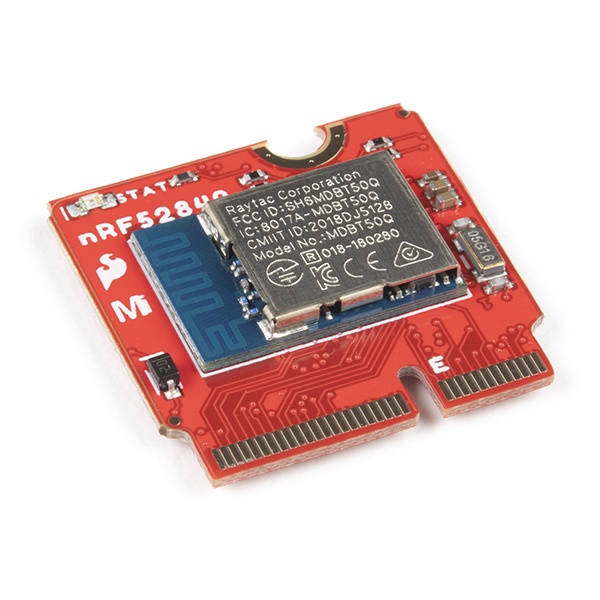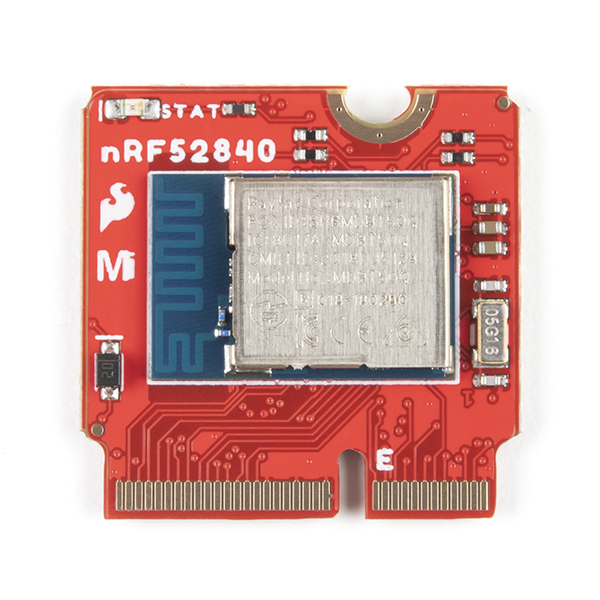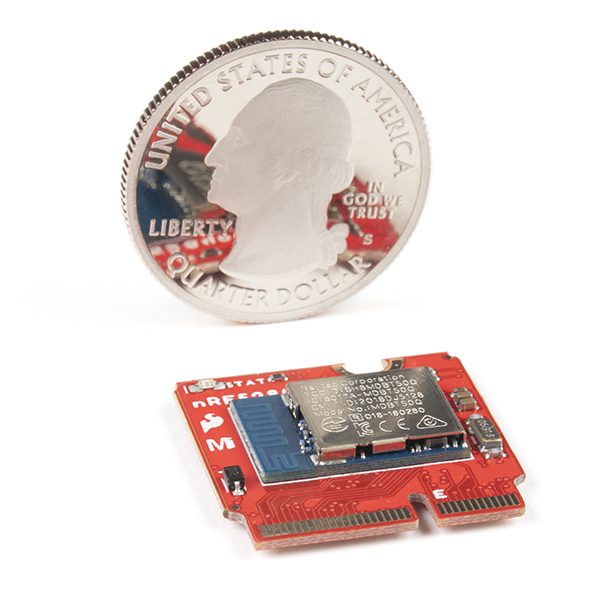SparkFun MicroMod nRF52840 Processor
Featuring the nRF52840 SoC from Nordic Semiconductor, the SparkFun MicroMod nRF52840 Processor offers a powerful combination of ARM Cortex-M4 CPU and 2.4 GHz Bluetooth transceiver in the MicroMod form-factor with the M.2 MicroMod connector to allow you to plug in a compatible MicroMod Carrier Board with any number of peripherals.
The MicroMod nRF52840 Processor features the same Raytac MDBT50Q-P1M found on our Pro nRF52840 Mini. This module includes an integrated trace antenna, fits the IC to an FCC-approved footprint along with including decoupling and timing mechanisms that would need to be designed into a circuit using the bare nRF52840 IC. The Bluetooth transceiver included on the nRF52840 boasts a BT 5.1 stack and supports Bluetooth 5, Bluetooth mesh, IEEE 802.15.4 (Zigbee & Thread) and 2.4Ghz RF wireless protocols (including Nordic's proprietary RF protocol) allowing you to pick which option works best for your application.
We've also routed two I2C buses, 2 SPI buses, eleven GPIO, dedicated digital, analog, PWM & PDM pins along with multiple serial UARTS to cover nearly all of your peripheral needs.
MicroMod is a modular interface ecosystem that connects a microcontroller “processor board” to various “carrier board” peripherals. Utilizing the M.2 standard, the MicroMod standard is designed to easily swap out processors on the fly. Pair a specialized carrier board for the project you need with your choice of compatible processor!
nRF52840 General Features:
- ARM Cortex-M4 CPU with floating point unit (FPU)
- 1MB internal Flash -- For all of your program, SoftDevice, and file-storage needs!
- 256kB internal RAM -- For your stack and heap storage.
- Integrated 2.4GHz radio with support for:
- Bluetooth Low Energy (BLE) -- With peripheral and/or central BLE device support
- Bluetooth 5 -- Mesh Bluetooth!
- ANT -- If you want to turn the device into a heart-rate or exercise monitor.
- Nordic's proprietary RF protocol -- If you want to communicate, securely, with other Nordic devices.
- Every I/O peripheral you could need
- USB -- Turn your nRF52840 into a USB mass-storage device, use a CDC (USB serial) interface, and more. This is a big add compared to the nRF52832!
- UART -- Serial interfaces with support for hardware flow-control if desired.
- I2C -- Everyone's favorite 2-wire bi-directional bus interface
- SPI -- If you prefer the 3+-wire serial interface
- Analog-to-digital converters (ADC) -- Eight pins on the nRF52840 Mini Breakout support analog inputs
- PWM -- Timer support on any pin means PWM support for driving LEDs or servo motors.
- Real-time clock (RTC) -- Keep close track of seconds and milliseconds, also supports timed deep-sleep features.
Specific Peripherals available on MicroMod nRF52840:
- Three UARTs
- Primary tied to USB interface. Two hardware UARTs.
- Two I2C Buses
- Two SPI Buses
- Secondary SPI Bus primarily used for Flash IC
- PDM Audio Processing
- Two Analog Inputs
- Two Dedicated Digital I/O Pins
- Two Dedicated PWM Pins
- Eleven General Purpose I/O Pins
MicroMod nRF52840 Processor Documentation:
- Schematic
- Eagle Files
- Board Dimensions
- Graphical Datasheet
- Hookup Guide
- Datasheet - MDBT50Q Module
- Datasheet - nRF52840 IC
- GitHub Hardware Repo
MicroMod Documentation:
- SparkFun MicroMod Interface v1.0 - Pinout
- SparkFun MicroMod Interface v1.0 - Pin Descriptions
- Getting Started with MicroMod
- Designing with MicroMod
- MicroMod Info Page
- MicroMod Forums
- SparkFun Eagle Libraries (contains example footprints for the M.2 connector and SMD standoff)
- M.2 MicroMod Connector Datasheet
- MicroMod Reflowable Standoff Datasheet
SparkFun MicroMod nRF52840 Processor Product Help and Resources
MicroMod Weather Carrier Board Hookup Guide
January 14, 2021
A quick guide to help to create your own MicroMod weather station using the MicroMod Weather Carrier Board and Processor of your choice.
MicroMod nRF52840 Processor Hookup Guide
January 14, 2021
Get started with the MicroMod nRF52840 Processor following this guide.
MicroMod Asset Tracker Carrier Board Hookup Guide
February 25, 2021
Get started with the SparkFun MicroMod Asset Tracker Carrier Board following this Hookup Guide. The Asset Tracker uses the u-blox SARA-R510M8S LTE-M / NB-IoT module to provide a host of data communication options.
MicroMod WiFi Function Board - DA16200 Hookup Guide
November 11, 2021
Add IoT functionality to any MicroMod project with the MicroMod WiFi function Board - DA16200!
Core Skill: Programming
If a board needs code or communicates somehow, you're going to need to know how to program or interface with it. The programming skill is all about communication and code.
Skill Level: Competent - The toolchain for programming is a bit more complex and will examples may not be explicitly provided for you. You will be required to have a fundamental knowledge of programming and be required to provide your own code. You may need to modify existing libraries or code to work with your specific hardware. Sensor and hardware interfaces will be SPI or I2C.
See all skill levels
Core Skill: Electrical Prototyping
If it requires power, you need to know how much, what all the pins do, and how to hook it up. You may need to reference datasheets, schematics, and know the ins and outs of electronics.
Skill Level: Rookie - You may be required to know a bit more about the component, such as orientation, or how to hook it up, in addition to power requirements. You will need to understand polarized components.
See all skill levels
Comments
Looking for answers to technical questions?
We welcome your comments and suggestions below. However, if you are looking for solutions to technical questions please see our Technical Assistance page.
Customer Reviews
No reviews yet.





FYI: the layout doesn't match recommendations on page 14 of the datasheet: https://cdn.sparkfun.com/assets/learn_tutorials/8/2/0/Raytac_MDBT50Q.pdf
So may result in less than expected range.
Hi #1649277,
Thanks for the feedback. While the layout is not completely ideal for the module, the engineer made sure to route out the ground plane around the PCB antenna as much as they could along with including plenty of vias through the ground plane in the recommended areas to reduce antenna interference and range decrease on this Processor.
The pictures and schematic show a 128Mb flash part on the board but this isn't mentioned on the product page. Is this populated on parts being sold?
Are there any power consumption figures for the nRF52840 (e.g. transmit, sleep, etc.)? Would be helpful for potential users to have them listed on the "Features" tab.